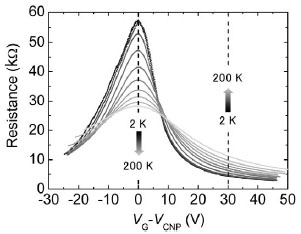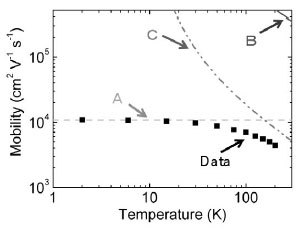Masao Nagase3, and Hiroki Hibino1
1Materials Science Laboratory, 2Physical Science Laboratory, 3The University of Tokushima
Monolayer graphene is expected to have high mobility due to its unique
electronic structure, and it is an attractive material for electronics
applications. Although its properties are being investigated in monolayer
graphene flakes obtained by mechanical exfoliation of graphite, mechanical
exfoliation is not suitable for obtaining large-area monolayer graphene.
Thus, establishing a method for its mass production is needed. Monolayer
graphene on SiC can be grown on a large scale by thermal decomposition
of SiC(0001) in an Ar environment [1]. In top-gated Hall bar devices using
monolayer graphene on SiC as the channel, promising results, such as ambipolar
characteristics and the quantum Hall effect, were obtained at 2 K [2].
As a further step towards utilizing monolayer graphene on SiC for devices
at room temperature, we investigated its electronic transport characteristics
up to 200 K.
Figure 1 shows the gate-voltage (VG) dependence of four-terminal resistance from 2 to 200 K. When VG is at the charge neutrality point (VCNP), the resistance decreases as temperature (T) increases. However, when VG is away from the VCNP, for example VG - VCNP = 30 V, the resistance increases as T increases. The T dependence of resistance at the VCNP is due to the increase of thermally activated carriers. The T dependence of resistance at VG away from the VCNP originates from decrease in mobility as shown in Fig. 2. The T dependence of mobility is determined by temperature-independent scatterings
(A), acoustic phonon scattering in graphene (B), and phonon scattering
from extrinsic sources (C). From the analysis in Fig. 2, the phonon scattering
from extrinsic sources, which is thought to be from the substrate, strongly
affects the T dependence of mobility [3]. The mobility decrease with increasing T is expected to be suppressed by controlling the phonon scattering from
the substrate.
This work was supported by KAKENHI.
[1] K. Emstev et al., Nature Mater. 8 (2009) 203.
[2] S. Tanabe et al., Appl. Phys. Express 3 (2010) 075102.
[3] S. Tanabe et al., Phys. Rev. B 84 (2011) 115458.
 |
 |
|||||
|
|